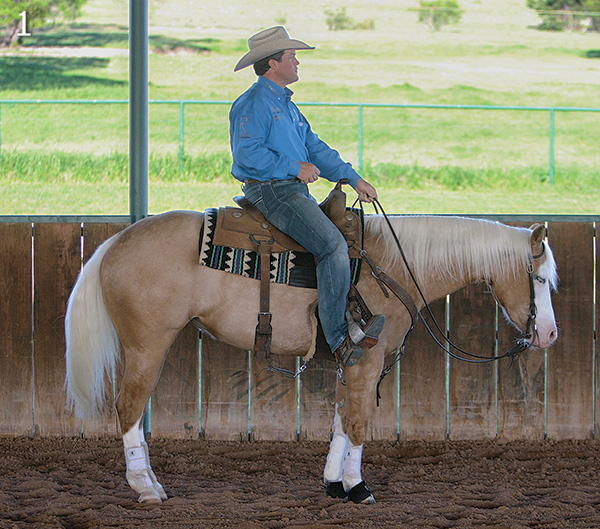Many riders don’t realize the influence their feet have on their horse when stopping. Tight, bracey feet make for a stop with those qualities—and that’s not something you want when being judged in the reining pen or anywhere else that requires a stop. No one wants to get lawn-darted, dashboarded, or slammed into the saddle when stopping.
Here I’ll outline key body-position pointers, focusing on your feet, to get a free, loose stop that slides farther or at least keeps you from landing on your horse’s neck. Practice in a bit that your horse responds to, and ride with one or two hands, whichever helps you feel comfortable and get the best stop from your horse.
1. When I work on running and stopping a horse, my body position stays as close as possible to the same position and form throughout the stop. My weight is balanced evenly in my feet—I’m not pulling them back, which tips my body forward, nor pushing them forward to brace against my horse. Ideally, I sit in the middle of my saddle, with my body perpendicular to the ground and my feet slightly in front of me. My shoulders and hips are square, with my shoulders slightly behind my hips, which helps my horse stop straight, and I’m sitting in an athletic riding position. Anytime I change my position, my horse has to adjust everything from the length and pace of his stride to his alignment from his nose to his tail to get under the weight of my body and the saddle. By minimizing my adjustment throughout the rundown and stop, I make it more likely that my horse will be set up for success when I ask him to stop.

2. If I run my horse with my feet behind me, in my horse’s sides, it pitches my body forward over his front end. As he goes along, he must adjust his body position under my weight. With all of my weight pushed forward, he tips onto his forehand, which prevents him from stopping deeply in the ground—he can’t get on his hindquarters with that extra bulk on his forehand. Instead, he’ll hit hard with his front feet and dashboard me. (Or maybe even send me flying forward out of the saddle, if he stops hard enough!)

3. I compare this position to sliding on the kitchen floor while wearing socks. I can run and get a good slide, but if someone is hiding behind the refrigerator and throws a backpack on me from behind, I’ll lose my balance. When I run to a stop and jam my feet forward, pushing my upper body backward, it’s as if I’m throwing that backpack on my horse and putting him off balance. I force his hind feet to enter the ground right at that point, whether he’s ready to stop or not. I also push his back down, which is the opposite of what I want in a good stop; I want his back to be nice and round. Our timing is off, and he’ll have to regather himself to attempt to stop again on my cue.
4. I’m running to a stop with my body in a ready-to-stop position. I’m perpendicular to the ground, with my feet slightly in front of me. I’m neither bracing in my stirrups nor pushing my feet behind me. My shoulders and hips are square to help him stop squarely and straight. This way, my horse is set up to stop. I’m not setting him up to fail by putting all of my weight on his front end, and I won’t surprise him with a sudden position change when I say “whoa.” We’re on the same page the whole time, all the way to the stop.

5. This results in a soft, deep stop. You can see that my position hasn’t changed much from how it looked in Photo 1, when we were standing still. My chin and eyes are up, and my seat is deep in the saddle, allowing my horse to keep “accelerating” forward, even as he stops.
6. Ouch! By pushing my feet behind me, I’ve tilted my body forward, right onto the saddle horn when my horse stops. My discomfort aside, my horse has to try to keep his front end moving forward with extra weight on his forehand. He’s trying, but it’s not an easy task.

7. Bracing in my feet and pushing them forward to slam my horse into the ground results in a poorly timed stop. My horse’s hind end hits the ground when I slam my weight back, but then he has to regroup and continue on for a better-timed stop. My feet-braced-forward position also causes his back to hollow rather than round up during the stop. A simple change in the position of and weight in my feet could’ve helped this be a much better stop.
Casey Deary, Weatherford, Texas, had his most recent big wins at the 2016 NRHA Derby and the 2015 NRHA Futurity. In 2015, he joined the NRHA’s Million Dollar Rider roster. Casey and his wife, Nicole, have four children. Learn more at dearyperformance.com.






